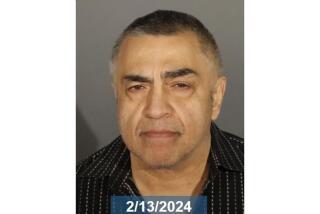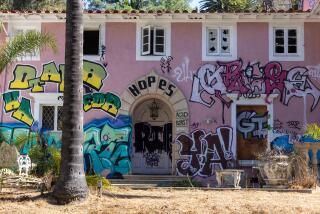Mohammed al-Fassi, 50; Sheik Known for Garish Estate, High-Stakes Divorce
- Share via
Mohammed al-Fassi, the Saudi Arabian sheik who provoked his Beverly Hills neighbors’ ire in the late 1970s when he painted his Sunset Boulevard mansion and its outdoor nude statues garish colors, has died. He was 50.
Al-Fassi, who was embroiled with his first wife in a long-running community property battle that also got wide publicity, died of an infected hernia on Dec. 24, in Cairo, Egypt, according to attorney Marvin Mitchelson.
Mitchelson represents al-Fassi’s estranged first wife, Sheika Dena al-Fassi, in the case between the legally separated couple.
In 1983, Dena al-Fassi was awarded nearly $82 million, or half of their almost $164 million in assets.
In addition to the Beverly Hills property, the assets included two Boeing 707 jets; 36 cars; a $15-million yacht, 26 horses; a zoo in Saudi Arabia; homes in Switzerland, London, Spain, Florida and Saudi Arabia; and millions of dollars in jewelry, gold coins, carpets, antiques and paintings.
But except for $7 million from the sale of their Beverly Hills home and an additional $1 million in insurance, Mitchelson said, Dena al-Fassi has not been able to collect.
The mid-1970s marriage of al-Fassi’s sister, Hend, to Saudi Prince Turki bin Abdul Aziz made al-Fassi’s extravagant lifestyle possible.
The tradition of the royal family is to financially support its immediate and extended family and al-Fassi directly benefited from his relationship with the royal family, Mitchelson said.
Born in Morocco, al-Fassi moved to Saudi Arabia when he was about 10. His father, a wealthy merchant, supplied goods to the royal family.
Al-Fassi met the Italian-born Dena in London in 1974; she was studying English and working part-time in a boutique.
They were married in 1975.
Al-Fassi first gained notoriety in 1978 when he paid $2.4 million in cash for his Beverly Hills mansion. It didn’t take him long to antagonize his neighbors.
He had the 38-room, white-stucco home painted a shade of green that one critic likened to the color of rotting limes.
He replaced the red tile roof with copper, filled the outdoor urns with plastic flowers and -- most jarringly -- had the classic Italian statuary surrounding the 3 1/2-acre estate painted in natural skin tones with the hair and genital areas painted to appear more lifelike.
The unorthodox paint job caused traffic jams on Sunset Boulevard as sightseers slowed to gawk and photograph the mansion, which was dubbed “a dirty Disneyland” by the press.
At one point, al-Fassi called a news conference to plead for his privacy.
As for the painted statues, he later told the Washington Post: “I saw them as plain and pale. I saw it as a personal touch. I can’t understand why anyone would object.”
When the mansion fell victim to arson in 1980 while the al-Fassis were abroad, many neighbors watched the spectacular blaze and chanted, “Burn! Burn! Burn!”
And when the mansion was sold and finally razed in 1985, 500 invited guests donned souvenir hardhats and marked the beginning of demolition with raised wine glasses. The land the mansion stood on remains vacant.
Al-Fassi was no less conspicuous a resident of Miami Beach, where he antagonized the community in the late ‘80s by installing a blue neon Arabic sign on the wall of his nine-room home facing Biscayne Bay: “In the name of God most gracious, most merciful.”
Over the years, al-Fassi continued to generate headlines.
Under Saudi law, sheiks and others may have as many as four wives.
And while still married to his first wife, he married aspiring American actress Victoria Sosa, who weeks later charged that he had bitten and beaten her and held her prisoner.
The suit was dropped after an out-of-court settlement.
Al-Fassi also faced lawsuits for allegedly failing to pay debts in Los Angeles and suits from former staff members who alleged that al-Fassi and other family members had abused them.
In 1992, he was at the center of a battle within the Saudi royal family.
Taking the Iraqi side during the Persian Gulf War, al-Fassi made radio broadcasts from Baghdad denouncing Saudi Arabia for allowing foreign troops into the country.
He also called for democracy in the kingdom and attacked the royal family.
In October 1991, while he and his family were staying at a hotel in Amman, Jordanian security forces arrested him and turned him over to the Saudi authorities who had demanded his extradition.
For months, he was held without charges in Riyadh before being placed under house arrest for about three years, according to Mitchelson.
He was finally banished from Saudi Arabia.
“They wanted him out of the country and took all his money,” the attorney said.
Last September, a Los Angeles Superior Court judge ruled that al-Fassi and Bin Abdul Aziz, his brother-in-law, must pay Dena al-Fassi $223 million.
The sum includes two decades of accrued interest.
Dena al-Fassi’s suit contended that the royal family had taken possession of all of Mohammed al-Fassi’s assets over the years. The ruling is the first to demand accountability from the Saudi kingdom.
“We haven’t seen it yet, but we definitely intend to collect it,” said Mitchelson, who plans to seek a further judgment against the king of Saudi Arabia and the kingdom itself at the end of January.
Al-Fassi, according to Mitchelson, had six wives, three of whom he divorced.
He is survived by his three wives, including Dena, seven children and a sister and brother.
More to Read
Inside the business of entertainment
The Wide Shot brings you news, analysis and insights on everything from streaming wars to production — and what it all means for the future.
You may occasionally receive promotional content from the Los Angeles Times.










